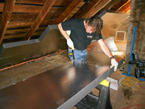In Business Since | License #
In Business Since | License #

Attic insulation plays a critical role any home’s overall comfort and energy efficiency. It can be installed in one of two places: on the attic floor or beneath the attic roof. Installing attic roof insulation (instead of attic floor insulation) has several benefits.
Properly installed attic roof insulation can eliminate many air leaks that waste energy and make parts of your house uncomfortable. With attic roof insulation, you’ll also get better performance from ductwork located in your attic.
The experts at Dr. Energy Saver are experienced in choosing and installing attic roof insulation. If you're looking to upgrade your insulation, give us a call or click below!
Although many builders have installed fiberglass batt insulation between attic rafters to insulate cathedral ceilings and attic roofs, this technique isn’t as effective as more modern methods of roof insulation.
Fiberglass insulation can compress and lose R-value; it’s also unable to stop air from leaking out of or into your house. Better materials for attic roof insulation are rigid foam boards and spray foam insulation.
Spray foam (technically known as Spray Polyurethane Foam or SPF)
is most commonly applied in the space between attic rafters. It can act as an air and moisture barrier in addition to providing very high R-value. If you are converting an attic to living space, SPF is a smart option to choose.


Two types of attic roof insulation. Spray foam (left) is applied between attic rafters using special equipment. Rigid foam insulation (right) can be installed directly below attic rafters.
Rigid foam insulation (like the SilverGlo® insulation from Dr. Energy Saver) comes in panels or sheets of different thicknesses. When used as attic roof insulation, rigid foam can be installed between attic rafters, directly beneath attic rafters, or in both locations. Like spray foam, rigid foam is an air and moisture barrier as well as high R-value insulation.
Fiberglass and rigid foam can be used together to provide effective attic roof insulation. The fiberglass batts are installed conventionally, between attic rafters. A thin layer of rigid foam is then fastened to the bottom edges of attic rafters.
Don’t guess about attic roof insulation. Contact Dr. Energy Saver, your home insulation expert. With access to the best selection of insulation materials available, Dr. Energy Saver installs the right insulation in the right way, proving you with the best performance and value. Call or email today to schedule a free insulation inspection and estimate.
Looking for a price? Get a no cost, no obligation free estimate.